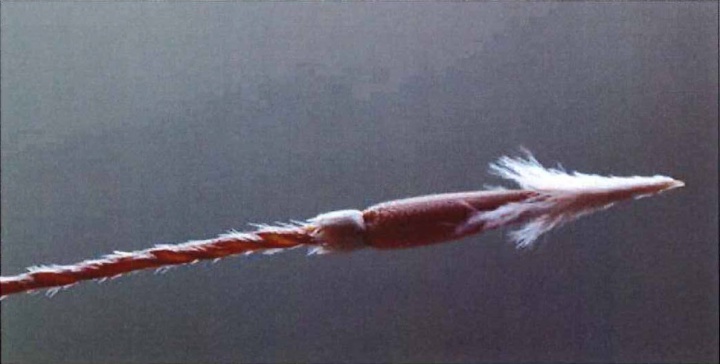Blunting Chilean needle grass
MONDAY, JANUARY 29, 2018
Blunting Chilean needle grass

Sharply pointed seed of Chilean needle grass (photo courtesy of Manaaki Whenua – Landcare Research)
New Zealand farming’s vulnerability to Chilean needle grass may be reduced if an application to release a rust fungus from Argentina wins approval from the Environmental Protection Authority.
Chilean needle grass is found at some 300 sites in New Zealand, covering around 4,000 hectares. But research suggests up to 15 million hectares may be potentially at risk.
Chilean needle grass is common in Australia and has caused production losses of up to 25 per cent in infested pastures. It displaces other types of grass, but is less palatable and nutritious to stock.
The grass also reduces the sale value of stock. Its sharply pointed seeds bore into the skins of grazing animals, damaging the pelt and reducing carcass value. It can also cause distressing wounds, sometimes blinding lambs and injuring farm dogs.
Marlborough District Council has applied to
introduce the rust fungus on behalf of a consortium of
regional councils and the Department of Conservation.
The
fungus – Uromyces pencanus – infects the leaves
of Chilean needle grass and competes with them for
nutrients, with debilitating effects. Its spores spread
rapidly on the wind.
A year-long study in Argentina found the fungus did not spread to plants other than the target needle grass. Other research suggests there is no direct threat to non-target plants in New Zealand, so no native or ornamental plants would be at risk.
This rust is unlike myrtle rust, which infects a wide range of plant host species within the Myrtaceae family. Myrtle rust arrived accidentally in New Zealand, whereas the introduction of U. pencanus would be intentional for a defined purpose – to control the invasive plant, Chilean needle grass.
The EPA will consider the risks and benefits before any decision is made to release the rust in New Zealand.
Public submissions on this application open on 29 January 2018 and close on 13 March 2018.
ends


 Business Canterbury: Urges Council To Cut Costs, Not Ambition For City
Business Canterbury: Urges Council To Cut Costs, Not Ambition For City Wellington Airport: On Track For Net Zero Emissions By 2028
Wellington Airport: On Track For Net Zero Emissions By 2028 Landcare Research: ANZAC Gall Fly Release Promises Natural Solution To Weed Threat
Landcare Research: ANZAC Gall Fly Release Promises Natural Solution To Weed Threat NZ Anti-Vivisection Society: Auckland Rat Lovers Unite!
NZ Anti-Vivisection Society: Auckland Rat Lovers Unite! University of Canterbury: $1.35 Million Grant To Study Lion-like Jumping Spiders
University of Canterbury: $1.35 Million Grant To Study Lion-like Jumping Spiders Federated Farmers: Government Ends War On Farming
Federated Farmers: Government Ends War On Farming



